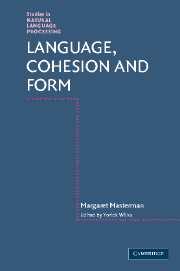Book contents
- Frontmatter
- Contents
- Preface
- Editor's introduction
- Part 1 Basic forms for language structure
- Part 2 The thesaurus as a tool for machine translation
- 4 The potentialities of a mechanical thesaurus
- 5 What is a thesaurus?
- Part 3 Experiments in machine translation
- Part 4 Phrasings, breath groups and text processing
- Part 5 Metaphor, analogy and the philosophy of science
- Bibliography of the scientific works of Margaret Masterman
- Other References
- Index
4 - The potentialities of a mechanical thesaurus
Published online by Cambridge University Press: 22 September 2009
- Frontmatter
- Contents
- Preface
- Editor's introduction
- Part 1 Basic forms for language structure
- Part 2 The thesaurus as a tool for machine translation
- 4 The potentialities of a mechanical thesaurus
- 5 What is a thesaurus?
- Part 3 Experiments in machine translation
- Part 4 Phrasings, breath groups and text processing
- Part 5 Metaphor, analogy and the philosophy of science
- Bibliography of the scientific works of Margaret Masterman
- Other References
- Index
Summary
There are five sections to this chapter:
The logical effect that adopting the logical unit of the MT chunk, instead of the free word, has on the problem of compiling a dictionary.
Dictionary trees: an example of the tree of uses of the Italian chunk PIANT-.
Outline of a mechanical translation programme using a thesaurus.
Examples of trials made with a model procedure for testing this: translations of ESSENZ-E, GERWOGL-I and SI PRESENT-A from the Cambridge Languages Unit's current pilot project. The simplifications that the use of a thesaurus makes in the research needed to achieve idiomatic machine translation.
Some preliminary remarks on the problem of coding a thesaurus.
1. In MT literature: it is usually assumed that compiling an MT dictionary is, for the linguist, a matter of routine; that the main problem lies in providing sufficient computer storage to accommodate it. Such judgements fail to take account either of the unpredictability of language (Reifler, 1954) or of the profound change in the conception of a dictionary produced by the substitution of the MT chunk for the free word.
By chunk is meant here the smallest significant language unit that (1) can exist in more than one context and (2) that, for practical purposes, it pays to insert as an entry by itself in an MT dictionary. Extensive linguistic data are often required to decide when it is, and when it is not, worthwhile to enter a language unit by itself as a separate chunk.
- Type
- Chapter
- Information
- Language, Cohesion and Form , pp. 83 - 106Publisher: Cambridge University PressPrint publication year: 2005



